Shevlin Sebastian's Blog, page 93
March 25, 2016
A Cinematic Genius
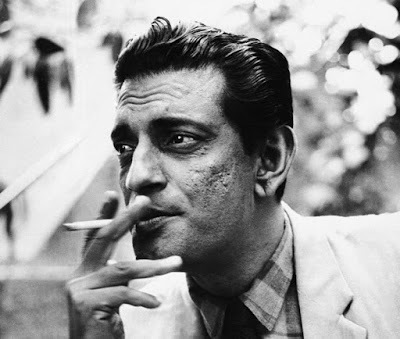
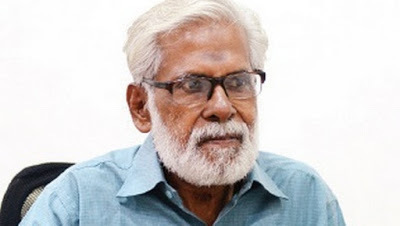 Noted Malayalam writer, MK Chandrasekharan, has written a book on the life and career of Satyajit Ray
Noted Malayalam writer, MK Chandrasekharan, has written a book on the life and career of Satyajit RayPhotos: Satyajit Ray; MK Chandrasekharan
By Shevlin Sebastian
When author MK Chandrasekharan was growing up in Muvattupuzha he would read articles about the great Bengali film director Satyajit Ray in Malayalam newspapers and magazines. So, one day, in 1956, when he came to know that Ray's film, 'Pather Panchali', was going to be shown at Laxmi theatre, he got excited.
However, when the 15-year-old reached the hall on the second day, the film had been removed. “Since it was a Bengali film, there was hardly anyone to see it,” says Chandrasekharan. It would take another 15 years before he would see the film at Kochi. But, in the intervening years, he saw, many other Ray films, like 'Jalsaghar', 'Apur Sansar', and 'Devi'.
In 1969, Chandrasekharan went to Kolkata, for a few days,en route to Bhubaneshwar, where he had to sit for an exam. While there, he saw Ray's popular children's film, 'Goopy Gyne Bagha Byne'. The next afternoon, the hotel manager told Chandrasekharan that Ray had also been present for the same show. A disappointed Chandrasekharan decided to go to Ray's home to meet him. But when he went there, he was told that Ray had left for Rajasthan. Nevertheless, Chandrasekharan continued to see numerous films of Ray, as well as read articles on and by him.
In 2011, Chandrasekharan had gone to Kolkata to do research on a book on Mother Teresa. And that was when he got the idea to write a book on Satyajit Ray.
The book, ‘Satyajit Ray – Cinema and Life', published by Green Books, has just been released in Malayalam.
The book discusses Ray's films, as well as recounts events from his life. These include the difficulties of getting the finance to make his first film, 'Pather Panchali'. Ray managed to shoot three-fourths of the film. Then he ran out of money. In desperation, he approached the then Chief Minister BC Roy, who happened to know his mother.
“When Roy heard the script, he asked the director whether there could be a happy ending,” says Chandrasekharan. “But Ray said that the script is based on a popular novel by writer Bibhutibhushan Bandyopadhyay and readers will get very angry if there is a change.” In the end, the Public Works Department granted a loan for a documentary about roads. The words, 'Pather Panchali' means, 'A song of the little road'.
When the film was released, it had an instant worldwide impact, especially when it was screened at the Cannes film festival in 1956, where it won the 'Human Document' Award. Today, it is regarded as a masterpiece of world cinema.
Asked about the qualities of Ray as a director, Chandrasekharan says, “He shows the true India. There are no stunts or fights. His films are accessible to the common man. You need patience to see films by Adoor Gopalakrishnan, Kumar Shahani, and other art-film directors, but there is always a good pace in Ray's films. We never get bored.”
The book explores the different phases of Ray's film career. So Chandrasekharan focuses on the Kolkata films: 'Pratithdwandi', 'Seemabhadda' and 'Jana Aranya; on films based on the stories of Nobel Laureate Rabindranath Tagore: 'Teen Kanya', Charulata', and 'Ghare Baire', the Apu Trilogy and the Hindi films, 'Shatranj Ke Khilari' and 'Sadgati'.
Chadrasekharan also trains a spotlight on Ray's affair with his leading actress Madhabi Mukerjee. “They broke up after a while, because Ray felt it was not right,” says Chandrasekharan. Ray's wife is his first cousin, Bijoya, whom he married after a nine-year courtship. “To me, Ray is one of India's greatest film-makers,” says Chandrasekharan. “After all, he has won the Bharat Ratna and is the only Indian to win an Honorary Oscar for lifetime achievement.”
(The New Indian Express, Kochi and Thiruvananthapuram)
Published on March 25, 2016 21:38
March 23, 2016
Design of Choice School, Tiruvalla, is on shortlist for international architecture awards

 By Shevlin SebastianThe management of Choice School, Kochi, is waiting, with bated breath, for April 12. That is the day when the results will be announced for the much-respected Architizer Awards. The design of the new Choice School, Tiruvalla, by award-winning American architect Cetra Ruddy, is in the Global Top 5 in the ‘Unbuilt Institutions’ Category.
By Shevlin SebastianThe management of Choice School, Kochi, is waiting, with bated breath, for April 12. That is the day when the results will be announced for the much-respected Architizer Awards. The design of the new Choice School, Tiruvalla, by award-winning American architect Cetra Ruddy, is in the Global Top 5 in the ‘Unbuilt Institutions’ Category.Asked about the Architizer awards, Nicole Tetreault, Senior Marketing Manager, said, from New York, "It celebratesthe year’s best architecture, and champions designs which have a positive impact on everyday life. Thus far, we have received thousands of entries in 115 categories from over 100 countries."
Around 350 judges selected the five finalists in each category. Thereafter, they will select the jury winners. Meanwhile, the names of the finalists have been released to the public so that they can vote online. “We give a popular choice award based on the votes,” says Nicole. “Sometimes, the popular and jury choice winners are for the same project.”
While there is no prize money, the winners are invited to attend a gala, in May, at New York where they are presented with an A+ Awards Trophy.
Principal architect John Cetra is thrilled. “To reach this far in the competition, all the final candidates are already winners in their own right,” he said. At this moment, Choice is leading, with 49 per cent, while the next competitor is Smart School in Irkutsk, Russia, at 23 per cent.
“We are happy to be leading,” said Jose Thomas, President, Choice Foundation. Asked how he selected Cetra Ruddy, who was recently inducted into the architectural Hall of Fame, Jose said, “Normally it would not have happened because their standard fees would not have made it viable for a school project in India.” However, Jose has a close friendship with John. “I told John that he should do something to radically alter the face of education in India,” said Jose. And the latter agreed.
One radical change is that the classrooms will be less like a hall. Instead, in each class, there will be several tables where students will sit around, like in American schools. There will be large latticed windows at one side and colourful murals on the walls. The staircases will be made of wood. The ceilings are being decorated with acoustic wooden baffles and there will be plants and palm trees growing inside the grand atrium.
The fully air-conditioned school, which has an area of 2 lakh sq. ft., has five interconnecting blocks: a hostel, a performing arts centre, a primary, middle and high school. “The design resembles '5 fingers', which crisscross and reach out in different directions,” says John. A total of 3000 students will be accommodated.
The first phase will be inaugurated in June.
(The New Indian Express, Kerala editions)
Published on March 23, 2016 20:37
March 20, 2016
A Verbal Thrust And Parry
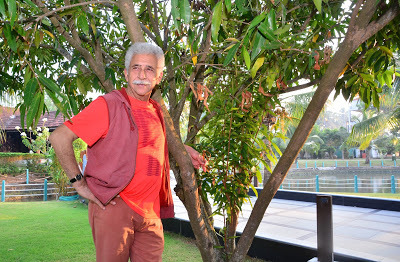
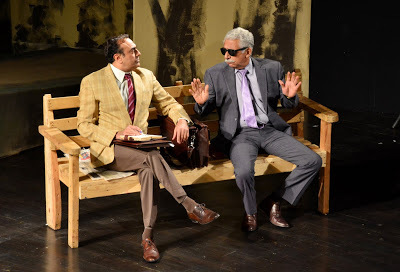 Naseeruddin Shah impresses, along with Rajit Kapur, in the English play, 'A Walk In The Words' and talks about his enduring love for theatre
Naseeruddin Shah impresses, along with Rajit Kapur, in the English play, 'A Walk In The Words' and talks about his enduring love for theatrePhotos by Ratheesh Sundaram
By Shevlin Sebastian
“Jamaluddin Saab,” says Ram Chinappa.
“Call me Jamal,” says Jamaluddin. “In fact, my friends call me Jams. What about you? Do they call you Pants?”
This witty exchange is from the English play, 'A Walk In The Woods', which was held at the JT Pac, Kochi, on March 6. While Naseeruddin plays Pakistani diplomat Jamaluddin Lutfullah, Rajit Kapur plays Ram Chinappa, the Indian interlocutor. They are both in Geneva to discuss peace proposals. The play is an adaptation of the original work, written by American Lee Blessing in 1988, and has been directed by Naseeruddin's wife Ratna Pathak.
Thanks to the amusing thrust and parry between Naseeruddin and Rajit, laughter breaks out often, in the sell-out audience, which includes superstar Mohanlal. “These two try to find some common ground, as diplomats and human beings,” says Naseeruddin. “Their attempts don't result in anything fruitful, but does raise the possibility of a personal friendship between an Indian and a Pakistani.”
There is no doubt that Naseeruddin, at age 66, is still in top form. Or, as Mohanlal said, at the end of the play, “Naseer is a great actor.”
Naseer is part of a group of rare actors, who, despite commercial successes in Bollywood, continue to do theatre.
“I love theatre,” he says, during an interaction before the play. “One can engage with the greatest writing in the world of the past one thousand years. You can do an ancient Greek play, or a 500-year-old [William] Shakespeare play. Where do you get that level of writing in films? And when you engage with great writing over a period of time, it slowly reveals itself. After the 100th performance, we realise that what we did in the first show was not that good.”
Naseeruddin also likes the bareness of theatre. “We prefer to use only words and actors,” he says. “When Shakespeare was doing his plays, there was nothing on stage. And he created worlds out of words. He had very little props. There was a man shaking a tin can to create thunder. To get the sound of gunfire, a cannon would be fired, and once a theatre caught fire because of that.”
Regarding the difference between film and theatre acting, Naseeruddin says, “There is no difference. People imagine that, on stage, you have to enlarge your performance. But the person, sitting in the last row, if he is focusing on your performance, is able to see everything. The human eye has a greater level of focus than any camera lens.”
But the best part for Naseeruddin is the feeling of exhilaration he feels while interacting with the audience. “It is not only the applause, response, laughter and live reactions,” he says. “There is something deeper than that. It is a subconscious connection between the actors and the audience.”
Meanwhile, when asked about the current talent level, Naseeruddin mentions noted Marathi movies like 'Masaan' (Neeraj Ghaywan), 'Court' (Chaitanya Tamhane), and 'Highway' (Umesh Vinayak Kulkarni). “I also liked the Hindi film, 'Dum Laga Ke Haisha' (Sharat Katariya),” he says. “These directors are the treasures of today. And they would not have been here without the Shyam Benegals and Govind Nihalinis who had come earlier. And they would not have been there, without the Mrinal Sens, Ritwik Ghataks, and Adoor Gopalakrishnans.”
After more than 40 years in the trade, with movies like 'Aakrosh', 'Sparsh', 'Mirch Masala', 'Albert Pinto Ko Gussa Kyon Ata Hai', 'Nishant', 'Junoon', 'Ardh Satya', and 'Jaane Bhi Do Yaaro', and winning numerous acting awards, as well as the Padma Bhushan, Naseeruddin has had a successful career. But his definition of success is unusual.
“Success, to me, is to be able to do what you want to do,” he says. “If I feel like doing a commercial movie for lots of money I can do that. If I feel like doing a small Rs 50 lakh movie to be shot in the interiors of Kerala, I do it. If I feel like doing a play, or a workshop for students, or resting for two months and playing tennis, I can do that.”
(Sunday Magazine, The New Indian Express, South India and Delhi)
Published on March 20, 2016 22:32
March 18, 2016
Attached To Each Other
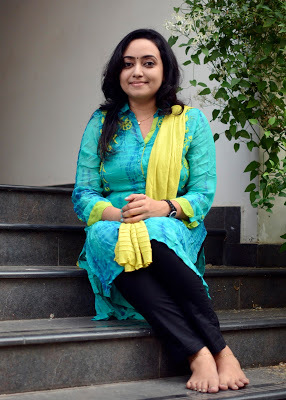
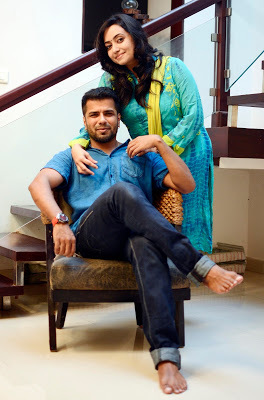 COLUMN: Spouse's Turn
COLUMN: Spouse's Turn Lakshmi talks about life with the violinist Bala Bhaskar
Photos by Manu R Mavelil So, without informing their parents, they had a registered marriage, on December 20, 2001, at Thiruvananthapuram, in the presence of a few friends. Today, fifteen years later, the news is good. Both sets of parents have accepted their marriage and they are blissfully in love.Asked to list Bala's plus points, Lakshmi says, “He is committed to his music. Bala puts in 100 per cent in whatever he is doing, whether it is a jingle or a song. And even though he is always busy, travelling from city to city, he will never say, 'I cannot do this for you because I am travelling or busy'. He is always there for me.” His negative quality is a short temper. “That is because he is a sensitive and emotional person,” says Lakshmi. “If he feels hurt, he will react. But I have got used to it.” And Lakshmi has also got used to the fact that music is his greatest passion. “I don't have a problem with that,” she says. “Because music makes my husband so happy. I can see it in his eyes when he is performing. He becomes a different person on stage. Bala loves to do shows, and gets so encouraged by the vibes of the audience. A performance is a kind of meditation for him.” But her happiest moment has been away from music. That was when they went for a one-week vacation to Dubai sometime ago. “It was the first time that I could spend time with him, without any disturbances,” she says. “We enjoyed shopping, ate good food and saw lots of nice places.”
(The New Indian Express, Kochi, Thiruvananthapuram and Kozhikode)
Published on March 18, 2016 22:08
March 15, 2016
Unexpected Deaths And Business Calamities
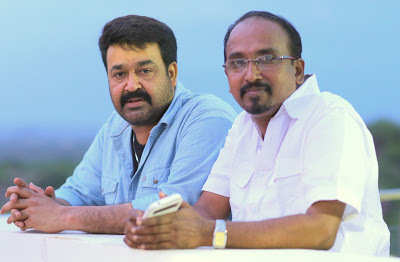
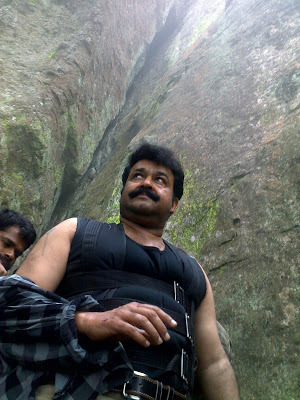 COLUMN: LOCATION DIARY
COLUMN: LOCATION DIARYScriptwriter S. Suresh Babu talks about his experiences in the films, ‘Shikkar’ and ‘Kanal’
Photos: Mohanlal with S. Suresh Babu (right); Mohanlal on the sets of 'Shikkar'
By Shevlin Sebastian
When the casting was being done for the film, ‘Shikkar’ (2010), a lot of names were suggested regarding the actor who would play the friend of Mohanlal.
“It was then that I suggested Sreenath, a brilliant actor, who was acting in television serials at that time,” says ‘Shikkar’ scriptwriter S. Suresh Babu. In ‘Kireedom’ (1999), he had played a friend of Mohanlal, so the latter also accepted the recommendation.
But when shooting began, at a bamboo forest in Kothamangalam, it was clear that Sreenath was not at his best. “Later, we heard that some ruffians had gone to the hotel in Kothamangalam, where he was staying, and threatened him,” says Suresh. “Apparently, he owed money to a lot of people.”
When the first part of the shoot was over, Sreenath was told that he could go home and would be called later.
On the morning of April, 23, 2010, a taxi driver arrived at the hotel in Kothamanagalam to collect him. But there was no response when calls were made to the room. Ultimately, the door was opened, by hotel employees, using the reserve key.
Sreenath lay unmoving on the bed. Police later said that he had committed suicide. “It came as a big shock to all of us on the set,” says Suresh. “We felt sad, because Sreenath was only in his fifties.” Shooting was suspended for two days, as the police had to conduct an enquiry. In the end, Lalu Alex played the role.
Near the end of the two-month long shoot, the climax was shot at Devil's Kitchen in Kodaikanal. This is a forest at a height, between a valley and three gigantic rocks. “It is a scene where Mohanlal's daughter, in the film, played by Ananya, is hidden there by some villains and he comes to rescue her,” says Suresh.
But it was a dangerous place. There are certain spots where there are holes in the ground through which one can slip through and fall all the way to the bottom. “You cannot survive such a fall,” says Suresh. “Guides had to use sticks and hit the ground ahead of them as they walked.”
Director M. Padmakumar decided to use four cameras. Out of the four, one of the cameras was to be placed at a lower level pointed upwards. As the crew members were going down, suddenly they came across a body lying on the branch of a tree.
It was a horrific sight: decaying flesh and pieces of bone could be seen, apart from a putrid smell. “Maybe, the man fell by accident or committed suicide,” says Suresh. “But the guides and forest officers told us that this was a regular sight, as many people went there to kill themselves.”
Despite these bad omens, when ‘Shikkar’ was released, it became a big hit. “So although I felt sorrowful about Sreenath's death, I was glad that, after all the difficulties, the film did well,” says Suresh.
On another occasion, Suresh went to Dubai to do research on a story on the global recession of 2008. While there, he met Kurup (name changed), a Malayali, who used to own four hotels. But the recession destroyed his business. “Kurup was staying in the storeroom of one of the hotels, because he had no place to stay,” says Suresh.
Kurup became the inspiration for the character of businessman Kuruvilla Mathew Iype (played by Atul Kulkarni) for the film, ‘Kanaal’ (2015), which was written by Suresh, and starred Mohanlal and Anoop Menon.
However, when the United Arab Emirates government refused permission to shoot the film in Dubai, because the theme was recession, the crew shifted to a labour camp in Doha, Qatar. After a careful search, they discovered a small and shabby room to do a few scenes. In fact, a Malayali, Ravindran (name changed) was using that room.
After the shoot was over, Suresh told Ravindran about the theme of the film. “Ravindran became emotional,” says Suresh. “He told me that he had been doing very well as a businessman in Dubai, but lost everything in the recession. So, he came to Qatar and was now working as a labourer. I thought to myself, ‘From Kurup to Ravindran, what a coincidence’. ”
(Published in The New Indian Express, Kochi, Thiruvananthapuram and Kozhikode)
Published on March 15, 2016 23:32
March 13, 2016
Kerala's Super Mouse
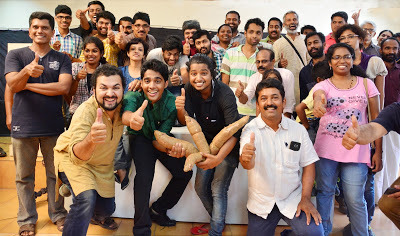
 Many youngsters in Kerala are fans of the comic book hero Dinkan. But they use him to mock formal religion and outdated beliefs
Many youngsters in Kerala are fans of the comic book hero Dinkan. But they use him to mock formal religion and outdated beliefsPhotos: Dinkoists at a meeting in Kochi. They are holding a large tapioca and giving the 'Dinka, Dinka' greeting with their thumb; Photo by Ratheesh Sundaram. The comic hero DinkanSays Dinkan devotee Samoosa Thrikonadhyaya, “He is the god of the universe. We also believe in the Big Laugh theory, which says that the entire universe originated from the big laugh of Lord Dinkan.” So, clearly, the protests against Dileep were a clever way of making fun of organised religions. They also pretend to get offended when anybody questions the divinity of Dinkan or their 'Holy Book' Balamangalam. “We were also making fun of those who protested against films like 'Hey Ram', 'PK' and 'Vishwaroopam',” says writer KS Binu. “We believe in a free and just society, based on scientific and rational thinking.”After a while, the girl said, “I feel all right now. Thank you Lord Dinkan.” Then the Dinkoists raised their right thumb, shifted it sideways rapidly, and shouted, 'Dinka', 'Dinka'. “This is our way of greeting each other,” says Sarita.But Vinuraj enjoyed their parody skits. "There should be more groups like this, who can come up with new and interesting ideas," he says. "It will energise our society.”
Published on March 13, 2016 21:50
March 12, 2016
In Search Of An Unique Gift, A Father Writes About His Son
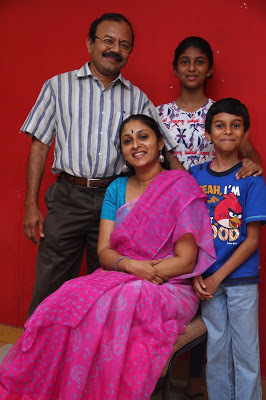 By Shevlin Sebastian
By Shevlin SebastianPhoto: Characters in the story. Photo by Mithun Vinod.
A few days ago, while I was walking with my 12-year-old son, Subin, he told me, “Baba, from the back, your head looks like the top of a cashew nut with bits of hair on the sides.”
“Should I wear a wig,” I said.
“No, it's fine,” he said.
This talented boy always has an interesting take on the world. And a big heart. One of my unforgettable memories of Subin was when his mother was unwell and was lying in bed. And she wanted to eat something.
Subin, who was in Class 4, went to the kitchen, broke an egg, pored the yolk into a bowl, added salt, and stirred it. Then he pulled up a chair, lit the gas stove, placed a pan, and made an omelette, which he gave to his mother.
And so, sometime ago, when his First Holy Communion ceremony was going to take place, I wracked my brain on what unique gift to give to him.
And then the idea struck me: why not write an article about my son. After all, as a journalist, I write about all sorts of interesting people, from Edmund Hilary at a hotel in Darjeeling to a beggar outside St Mahim's church, Mumbai, who, astonishingly, turned out to be a Malayali.
So here is the gift of thoughts and reflections:
“When Subin was small he would look at the sweets placed in a glass bottle on our dining room table [at Kochi],” says Rani Vadakel, Subin's grand aunt. “He would never take it without getting permission. To get it, Subin would knock on the table, and get our attention. When we give it, he would take not only for himself but for [his sister] Sneha also.”
Classmate Aaron Joseph Pramod says that Subin is a good boy. “He reads a lot,” says Pramod. “Among our friends, Subin is the smallest. Sony, who is taller than Subin, carries him around. Subin does not like it much and says, ‘Put me down’. When the class teacher is there, he is very quiet. But when we have a free period, he talks a lot.”
Says Molly Isaac, maternal grandmother: “Sometimes, Subin will ask me whether I miss my husband [who died in 2003]. Compared to other children, he has the ability to understand people far better than most. This is a gift from God. If I tell him I am going to the shop, he will immediately say, 'Grandma, don't go alone. I will come’.”
To cousin Aneesha Jose, Subin is an extremely fun-loving and jovial person who knows how to tickle the funny bone of even the most serious person. “He has the greatest dance moves and can remember the lyrics of a hundred songs,” says Aneesha. “He can lighten the mood in any situation. Everyone loves being around him. Even though his size may be small, he has the biggest heart.”
As for Subin’s mother, Sini, she remembers getting a letter one day from Subin.
On the cover, it was written, 'A Sorry and a Thank You note'.
Inside, Subin wrote:
Thank you1) For ironing our clothes2) For washing the dishes3) For praying for us4) For sweeping the house5) Loving and taking care of us
Sorry for:
Not helping youHurting youNot doing things on time
This exercise was an eye-opener. At the end of it, I realised that, like all parents, I hardly knew my son, even though he is living right next to me. So, what is the possibility that I will know anything when Subin grows up and moves away?
And this also proved, once again, that the immortal words of Kahlil Gibran in 'The Prophet' are absolutely true:
‘Your children are not your children.
They are the sons and daughters of Life's longing for itself.
They come through you but not from you,
And though they are with you, yet they belong not to you.’
(Published as a middle in The New Indian Express, South India editions)
Published on March 12, 2016 05:20
Celebrity Cricket Club gives money to endosulfan victims
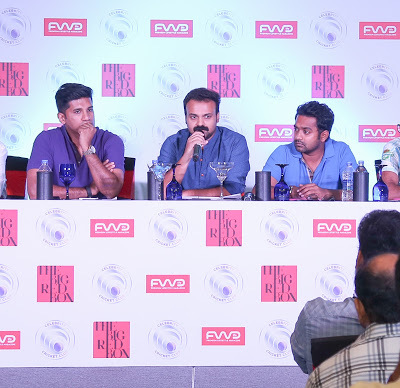
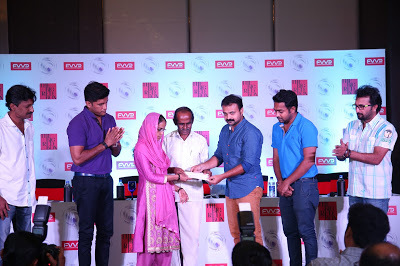 By Shevlin Sebastian
By Shevlin SebastianPhotos: (From left: Vijay Yesudas, Kunchacko Boban and Asif Ali); Kunchacko Boban giving a chequ of Rs 4.5 lakh to Munisa, representative of the Sneha Veedu organisation
A few years ago, singer Vijay Yesudas and his friend Nikhil Menon would play cricket outside the Jawaharlal Nehru Stadium, Kochi, as members of the Kochi City Tigers. “”We would play matches now and then,” says Vijay, at a press conference today. “I have warm memories of that time.” Thereafter, there arose a desire to involve the members of Mollywood. Soon, Indrajit Sukumaran and Prithviraj and others joined in, and they played at a ground at Thevara.
In 2008, the Celebrity Cricket Club (C3) was formed. “It is a brotherhood of actors, singers, directors, producers and the like,” says Vijay, the secretary of C3. Adds Kunchacko Boban, the chairman, “All of us have a passion for the game. By playing together, it strengthened our friendships. But over a period of time, we realised that we would also like to contribute to charity. ”
So, the C3 team played charity matches at Sharjah and in London.
Fast forward to March 9. The C3 gave a cheque of Rs 4.5 lakh to the Sneha Veedu organisation, which looks after endosulfan victims. The cheque was collected by the representatives, Kunjikannan and victim, Munisa. The idea came after Kunchacko went to Wayanad to act in the film, ‘Valiya Chirakulla Pakshikal’’’, which is based on the endosulfan issue. “I met many victims and was moved by their plight,” says Kunchacko. ”We have plans to help more people.”
Adds Asif Ali: “ We are now planning to play matches in South Africa, Australia and the US. And we request sponsors to come forward. ” In fact, the England match was generously sponsored by the Malayalis living there. They also have plans to set up a music band. Alongside matches, they will do shows, to generate funds for their charity initiatives. The C3 team includes actors Nivin Pauly, Unni Mukundan, Saiju Kurup, Jojo George, singers Afsal and Madhu Balakrishnan, and directors Lijo Jose Palliserry, Deepan and others.
(The New Indian Express, Kochi and Thiruvananthapuram)
Published on March 12, 2016 01:05
March 10, 2016
A Jeep Accident That Almost Became A Tragedy
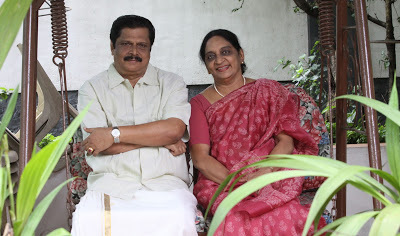
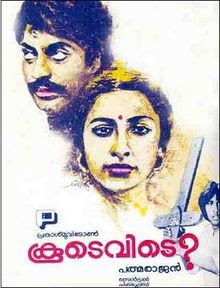 COLUMN: LOCATION DIARY
COLUMN: LOCATION DIARY Prem Prakash talks about his experiences as a producer in the films, 'Koodevide', 'Akasha Dootu' and Peruvazhiyambalam'
Photos: Prem Prakash with his wife Daisy. Photo by Rajeev Prasad. Film psoter of 'Koodevide'
By Shevlin Sebastian
At 7.30 p.m. on a day in August, 1983, the day's shooting for the film, 'Koodevide', concluded in the mountainside town of Doddabetta in Ooty.
A little while later, actors Mammooty and Maniyanpilla Raju were returning in a jeep. There were a few other crew members sitting at the back. They were being followed by another jeep which consisted of producer Prem Prakash, actor Suhasini, director P. Padmarajan and camera person Shaji N Karun.
“Since Mammooty drives very fast, he went ahead quickly,” says Prem. “It was also a foggy night. But after a while, we saw a shocking sight. The jeep, which Mammooty had been driving, had overturned.”
Maniyanpilla Raju was lying on the ground. Apparently, a lorry was coming from the other side, and Mammooty braked suddenly, at high speed. As a result, Maniyanpilla Raju slipped and fell to the ground.
They rushed him to the Ooty General hospital. Water was splashed on his face, but he continue to remain still. “We felt that Maniyanpilla had died,” says Prem. “Because he remained without responding in any way.”
Meanwhile, Mammooty was walking up and down the corridor and said, “What do we do?” Says Prem: “I have never seen Mammooty so scared and worried.”
After a long time, Maniyanpilla Raju opened his eyes and said, “Where am I?” That was when the crew suspected that he had a brain injury. “However, in the end, it turned out okay,” says Prem. “But for some time we thought the worst had happened. And Mammooty was so worried that he would have been the cause of his death.”
There were no such tensions in the making of the film 'Akasha Dootu' (1993). However, when the melodrama, directed by Sibi Malayil, was released, Prem heard that that there was a lot of crying in the hall. It is the story of a widow, who is dying of leukamia, who gives away her four children for adoption.
“So, as a producer, I decided that when a patron bought a ticket, he would also get a handkerchief,” says Prem.
Anyway, to watch the effect of the film, Sibi and Prem went to a theatre in Nooranad, in Alleppey district. They stood at the back of the balcony. In one of the seats sat Jacob Thomas, 34, his wife Maria, 27, and a six-year-old boy, Rony (names changed).
Very soon into the melodramatic film, Maria started crying. Jacob said, “Why are you embarrassing me by crying? This is only a film, not real life.” But Maria continued to weep when other sad scenes came up. And Jacob continued to scold her.
“However, when the last scene came up, and the youngest boy, who is physically challenged, is finally adopted, Jacob burst out crying,” says Prem. “Now Maria said, 'What is happening? Why are you crying like this? And all along, you told me not to cry'.”
Prem and Sibi burst out laughing, at this point. “That was an experience I will never forget,” says Prem.
Another experience which Prem will not forget was at Balaramapuram, in Thiruvananthapuiram district where the shooting was going on for P. Padmarajan's debut film, 'Peruvazhiyambalam'. The year was 1979. At 2 a.m., Ashokan, who plays a fifteen-year-old by the name of Raman, kills the town's bully Prabhakaran Pillai (Azeez) because the latter raped Raman's sister. And then he runs away.
“It is but natural in a film that the townspeople chase him,” says Prem. “But at 2 a.m., there were no people around. And so it happened that to form part of the crowd, for the first time in Mollywood, Padmrajan and myself, director and producer, ran to be part of the crowd. It gives you an indication of Padmarajan's commitment.”
(The New Indian Express, Kochi, Thiruvananthapuram and Kozhikode)
Published on March 10, 2016 21:30
March 9, 2016
“In Coming Years, More Women Will Be In Positions Of Leadership”
 Says Mollywood star Lena, as she reflects on what it is to be a woman these days
Says Mollywood star Lena, as she reflects on what it is to be a woman these daysBy Shevlin Sebastian
In late 2014, Lena was on the sets of the Tamil film, 'Anegan', at Chennai. She was playing a psychiatrist by the name of Dr. Radhika. The villains are looking for the heroine, Madhumita, who is supposed to come to Radhika's clinic. However, there is a fight between the hero, Dhanush, and some villains.
“There is one scene where I was supposed to be pushed back by one of the goons,” says Lena. “The glass door of the clinic was supposed to remain open. And I had to move out of the scene. But the door closed accidentally. When I was pushed back against the door, the entire structure came crashing down. And the fighter fell on top of me.”
But the crew reacted with speed. “Within moments, they had lifted me and put me back on my feet, led by the fighter,” says Lena. “I was immediately rushed to the hospital. There was a small cut under my arm. A doctor put a stitch on it. I was ready to carry on shooting, but the director said it was pack-up time.”
Women have always been treated well in the film industries of the South. “I have been in Mollywood since 1998,” says Lena. “The men have always been considerate towards us. If I want to change costumes, and there are no facilities, they will go out of their way to find a suitable place. It is a family-like atmosphere. But in the Telugu and Tamil industries, we are treated like goddesses. So, on Women's Day, there is nothing to celebrate. I am already free and following my dreams.”
Her family members have been the inspiration. “My grandmother married the man she loved,” says Lena. “My mother left home [in Kochi] and went and worked in Chennai. She also married the man she loved and lived the life she wanted. In my family, the women have enjoyed a lot of freedom. Increasingly, this is happening all over the world.”
However, Lena does admit that in rural and backward areas, many women lack freedom, and are forced stop their education or get married against their wishes.
But the pendulum is moving towards women. “Since the end of the Mayan calendar [used by countries in Central America] in December, 2012, it has predicted a shift of power from the male to the female,” says Lena. “Feminine authority will increase. And there will be more women in positions of leadership worldwide. Women will enjoy their lives more. But, don't worry, guys will also like it when women enjoy life.”
Asked about the one drawback that women continue to have, Lena says simply, “Physical strength. For example, when I am alone, on a deserted road, at 7 p.m., I would experience fear because I don't have the physical strength to hold off a man. You also need strength to do simple things like carrying a suitcase to the third floor. Instead, I take a man's help. If God had given women physical strength, she would have become invincible. Maybe, that is why He did not give that attribute to her.”
When told that women have other negatives like mood changes and crankiness, a smiling Lena says, “Trust me, I know of many men who are equally cranky and short-tempered. So why blame women for that?”
(Women's Supplement, The New Indian Express, Kerala)
Published on March 09, 2016 23:01



